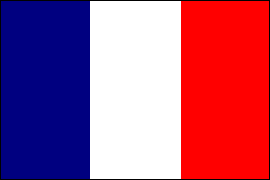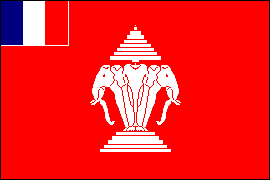ORIGINS OF THE TRICOLOR
|
|

White Royal Flag |

Flag of the City
of Paris |
|
 |
 |
|
Early Tricolor Variants
• 1789-94 |
|

The
1790 Naval Jack |

The
1794 National Flag |
The
Revolution of 1789, which transformed France into a constitutional
monarchy, did not immediately lead to a change of flags. The old
white royal flag, of which several versions existed, continued in
use. The colors blue, white and red were first used for the flags of
the National Guard, a military force raised by
Lafayette
to defend the revolutionary regime. The colors of many National
Guard battalions combined blue and red, the heraldic colors of
Paris, with royalist white. Soon there appeared a number of
unofficial three-color flags, mostly striped horizontally, and on 24
October 1790 the National Assembly passed a law establishing the
first official Tricolor. This was actually a
naval flag, vertically striped
red, white and blue, and bordered blue/red. In 1791, the
reorganization
of the French Army led to the adoption of new military colors. The
first battalion of each regiment received a flag with a canton
horizontally striped blue, white and red, and a blue/red border.
Finally, on 15 February 1794 ( 29 Pluviose of the Year II) the
National Assembly adopted the blue/white/red Tricolor as the
national flag and war ensign of the French Republic. In 1812 the
vertically striped Tricolor also became the standard pattern for
military colors on land.
|
|
THE REVOLUTIONS
OF 1830, 1848 AND 1871
|
|

National Flag
•
1848 |

The Count of Chambord's Tricolor |
The fall of Napoleon
and the restoration of the Bourbon monarchy (1814-15) led to the
abolition of the Tricolor in favor of the white royal flag.
The Revolution of 1830, however, which deposed the Bourbon King
Charles X in favor of the Orléanist Louis-Philippe, brought the Tricolor back.
During the Revolution of 1848, which deposed in his turn King
Louis-Philippe, there were demands for the Tricolor's
replacement by a
plain red flag.
The National Assembly briefly adopted a variant striped
blue/red/white, but only days later this flag was abolished and
the 1794 Tricolor was officially confirmed. Demands for a plain
red flag surfaced once more during the 1871 revolution, but the
suppression of the Paris Commune ended this threat to the
Tricolor. The conservative regime that assumed power after the
fall of Napoleon III favored a restoration of the monarchy but
this plan fell through when the Bourbon pretender, the Count of
Chambord, grandson of King Charles X, refused to accept the
by-then
traditional and popular Tricolor as the national flag of France.
"Henry V cannot abandon the white flag of Henry IV," he
insisted, thus making it inevitable that France would remain a
republic. Ironically, many years before the Count had sketched
a design for a royal Tricolor with the crowned arms of France on
the white stripe—a flag that might have enabled him to ascend
the throne of France.
|
|
DEFEAT & REDEMPTION • 1940-45
|
|

Vichy France |

Free
France |
After
1871 there was never any serious challenge to the primacy of the
Tricolor. Not even the catastrophic defeat suffered by France at the
hands of Nazi Germany in June 1940 led to a change of flags. Both
the collaborationist Vichy regime, led by Marshal Philippe Petain,
and
Free France,
the resistance organization led by General Charles De Gaulle,
claimed the Tricolor as its own. As Head of State, Petain had a
Tricolor displaying the baton (rendered as a medieval weapon, the
francisc) and seven stars of his military rank (Marshal of France),
but this was not a national flag. The Free French Tricolor, with the
Cross of Lorraine on the white stripe, was often flown as an
alternative to the plain Tricolor, particularly by Free French naval
vessels. The plain Tricolor, however, continued to be universally
recognized as the true national flag of France.
|
|
GOVERNMENT & COLONIAL
TRICOLORS
|
|

President of the
Republic & Prime Minister |
|

Colonial
Governor-General |

Colonial
Governor |
|

Laos •
1893-1952 |

French
Indochina • 1923-45 |
|

Syria •
1925-32 |

Autonomous State of Togo • 1956-60 |
The Tricolor has
served as a basis for military and
naval flags, distinguishing
flags of government officials, and colonial flags. Both the
President and the Prime Minister have a square Tricolor; that of
the former may, at the President's option, bear a monogram or
badge on the white stripe. Government flags
for use afloat have stripes proportioned
30:33:37 (like the
naval ensign), which is supposed to make the stripes appear
equal in width when viewed from a distance. The square blue flag, formerly used by colonial governors-general, is now the flag of government ministers with
responsibility for French overseas departments and territories.
Versions for use as car flags are proportioned 7:8 rather
than square.
Most colonial flags featured a Tricolor canton, though
unlike British colonial ensigns the size of the canton varied.
|
THE INFLUENCE OF THE TRICOLOR |
|

The Italian Tricolor • 1798
|
|

The Belgian Tricolor •
1831 |

The Romanian Tricolor •
1848 |
|

The Irish Tricolor •
1922 |

The Guinean
Tricolor • 1958 |
The French
Tricolor has had a great influence on flag design worldwide. Its
simplicity, distinctiveness and association with the ideals of
republicanism and nationalism led many other nations to adopt flags
of three stripes. Among the first was the green/white/red Italian
Tricolor, originally adopted in 1797 as the national flag of the
Cisalpine Republic. The Belgian Tricolor was based on the coat of
arms of the province of Brabant: a golden lion with red tongue and
claws on a black field. Its official proportions are an unusual
13:15—nearly square. Romania and Ireland also adopted flags based on
the Tricolor, as did many former
French colonies in Africa, the flag
of the Republic of Guinea being an example.
|
















